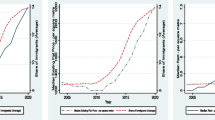Summary
In most traditional macroeconomic models for The Netherlands the wage equation is specified by a Phillips curve, in which wage growth is negatively related to the unemployment rate. This paper shows, however, that wage formation can better be described by the so-called wage curve, in which the wage level, instead of wage growth, depends negatively on the unemployment rate.
Similar content being viewed by others
References
Berg, P.J.C.M. van den, G.M.M. Gelauff and V.R. Okker (1988), ‘The Freia-Kompas Model for The Netherlands: A Quarterly Macroeconomic Model for the Short and Medium Term,’Economic Modelling, 5, pp. 170–236.
Blanchflower, D.G. and A.J. Oswald (1989), ‘The Wage Curve,’ NBER Working Paper 3181.
Blanchflower, D.G., A.J. Oswald and M.D. Garrett (1989), ‘Insider Power in Wage Determination,’ NBER Working Paper 3179.
Brunia, N. and G.H. Kuper (1990), ‘De specificatie van de afwenteling van de collectieve lasten,’Maandschrift Economic, 54, pp. 49–55.
Carruth, A.A. and A.J. Oswald (1987), ‘On Union Preferences and Labor Markets Models, Insiders and Outsiders,’Economic Journal, 97, pp. 431–445.
Central Planning Bureau (1989), ‘Fen verkenning van de Nederlandse economie voor de periode 1991–1994,’ Werkdocument 31.
Christofides, L.N. and A.J. Oswald (1989), ‘Real Wage Determination in Collective Bargaining Agreements,’ NBER Working Paper 3188.
Davidson, R. and J.G. MacKinnon (1981), ‘Several Tests for Model Specification in the Presence of Alternative Hypotheses,’Econometrica, 49, pp. 781–93.
Dimsdale, N.H., S.J. Nickell and H. Horsewood (1989), ‘Real Wages and Unemployment in Britain during the 1930s,’Economic Journal, 99, pp. 271–92.
Fase, M.M.G., P. Kramer and W.C. Boeschoten (1990), ‘MORKMON II, het DNB kwartaaïmodel van de Nederlandse economic,’ DNB, Monetaire Monegrafieën 11.
Friedman, M. (1968), ‘The Role of Monetary Policy,’American Economic Review, LVIII, pp. 1–17.
Graafland, J.J. (1988), ‘Hysteresis in Unemployment in The Netherlands,’De Economist, 136, pp. 508–523.
Graafland, J.J. (1990),Persistent Unemployment, Wages and Hysteresis, Doctoral dissertation, Rotterdam.
Graafland, J.J. (1991a), ‘Effecten van marginale belasting- en premiedruk op loonvorming,’Maandschrift Economie, 55, pp. 442–455.
Graafland, J.J. (1991b), ‘Insiders and Outsiders in Wage Formation: The Dutch Case,’Empirical Economics, forthcoming.
Hoel, M. and R. Nymoen (1988), ‘Wage Formation in Norwegian Manufacturing: An Empirical Application of a Theoretical Bargaining Model,’European Economic Review, 32, pp. 977–997.
Johnson, G.E. and P.R.G. Layard (1986), ‘The Natural Rate of Unemployment: Explanation and Policy,’ in: O. Ashenfelter and R. Layard (eds.),Handbook of Labor Economics, II, Amsterdam, pp. 921–999.
Knoester, A. and N. van der Windt (1987), ‘Real Wages and Taxation in Ten OECD Countries,’Oxford Bulletin of Economics and Statistics, 49, pp. 151–169.
Kuipers, S.K., B.W.A. Jongbloed, G.A. Kuper and E. Sterken (1988),CESAM, Het CCSO-jaarmodel van de Nederlandse economie, Groningen.
Layard, P.R.G. and S.J. Nickell (1986), ‘Unemployment in Britain,’Economica, 53, pp. s121-s169.
Lindbeck, A. and D.J. Snower (1986), ‘Wage Setting, Unemployment and Insider-Outsider Relations,’American Economic Review, Papers and Proceedings, 76, pp. 235–239.
Lipsey, R.G. (1960), ‘The Relation between Unemployment and the Rate of Change of Money Wage Rates in the United Kingdom, 1862–1957; A Further Analysis,’Economica, XXVII, pp. 1–31.
Mizon, G.E. and J.F. Richard (1986), ‘The Encompassing Principle and its Application to Testing Non-tested Hypotheses,’Econometrica, 54, pp. 657–78.
Nickell, S.J. and M. Andrews (1983), ‘Unions, Real Wages and Employment in Britain 1951–79,’Oxford Economic Papers, 35, supplement, pp. 183–206.
Oswald, A.J. (1982), ‘The Microcconomic Theory of Trade Unions,’Economic Journal, 92, pp. 576–95.
Phelps, E.S. (1968), ‘Money-wage Dynamics and Labor-market Equilibrium,’Journal of Political Economy, 76, part II, pp. 678–711.
Phillips, A.W. (1958), ‘The Relation between Unemployment and the Rate of Change of Money Wage Rates in the United Kingdom, 1981–1957,’Economica, XXV, pp. 283–99.
Pissarides, C.A. (1990),Equilibrium Unemployment Theory, Oxford.
Sargan, J.D. (1964), ‘Wages and Prices in the United Kingdom: A Study in Econometric Methodology,’ Reprinted in: D. Hendry and K. Wallis (eds.),Econometrics and Quantitative Economics, Oxford, pp. 275–314.
Author information
Authors and Affiliations
Additional information
The author thanks S.K. Kuipers and D.A.G. Draper and other colleagues of the Central Planning Bureau for their useful comments.
Rights and permissions
About this article
Cite this article
Graafland, J.J. From Phillips curve to wage curve. De Economist 140, 501–514 (1992). https://doi.org/10.1007/BF01725242
Issue Date:
DOI: https://doi.org/10.1007/BF01725242




